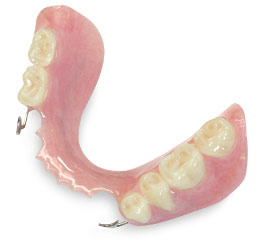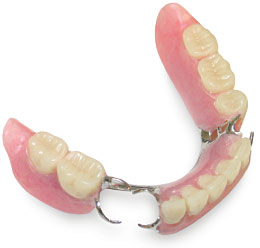Removable Partial Dentures
With proper care, RPDs can be a “stepping stone” toward permanent tooth replacement
Dear Doctor,
I am fifty-five years old and over the years I have lost several teeth, mostly due to decay. I've been wearing removable partial dentures for the last twenty years, the plastic “flipper type.” My dentist tells me that the denture is loose and it's affecting the health of my teeth and gums. Do you have any advice on alternatives?
 |
| Figure 1: An example of a transitional removable partial denture that is referred to as a “flipper.” |
 |
| Figure 2: An example of a cast vitallium removable partial denture. |
| Appliances (above) provided by William E. Verlin Certified Dental Laboratory Technician |
Dear John,
While removable partial dentures (RPDs) are certainly an alternative, the plastic type are generally more appropriately named temporary or transitional RPDs and they are certainly not the best design for long term use. The name “flipper” comes from the tongue's ability to flip them out or move them around. About the best use for these transitional appliances is as a temporary measure during healing, periodontal therapy, implant placement or like treatments. Thinking of temporary or transitional RPDs [Figure 1], as their name implies, as a “stepping stone” will help keep in mind that they are best used as short-term appliances.
Research dating back to the 1960s indicates that partial denture wearers [Figure 2] over the years suffer more decay and gum disease than non-partial denture wearers, all other variables being equal. The primary reason is that RPDs attach to the remaining teeth and other structures, the gum ridge areas where teeth once were, and the palate on which they rely for retention (to keep them in your mouth). Their attachment to other teeth can cause more bacterial plaque stagnation than usual, which leads to an increased incidence of both gum disease and tooth decay. Because RPDs attach to the remaining teeth they also tend to loosen the attached teeth over time. This occurs more often with temporary or transitional RPDs.
On the contrary and positive side, a well-constructed, accurately fitting thin metal-based removable partial denture, in a clean, plaque-free and healthy mouth, can provide a wonderful aesthetic and functional service. This is a big point that can't be stressed enough — excellent daily oral hygiene (brushing, flossing and the use of fluoride toothpaste, supplemented by mouthrinses), regular dental check ups and scrupulous care of the RPD (leaving it out at night and cleaning it thoroughly) are all pre-requisites for successful RPDs.
Thinking of temporary or transitional RPDs as a “stepping stone” will help keep in mind that they are best used as short-term appliances.
RPDs constructed out of a cast vitallium or gold alloy are much lighter weight and less obtrusive than the plastic kind. Tiny little rests and clasps are designed to grip the teeth rigidly and minimize the deflecting forces of the bite. A cast vitallium RPD is a little more expensive than a plastic RPD but much less expensive than implants or bridgework, the fixed, non-removable alternatives. While these latter prostheses (tooth replacements), particularly implants, are currently the treatment of choice, there are still many happy and satisfied RPD wearers around.
We hope this begins to answer your great question — please consult with your dentist for additional information.




